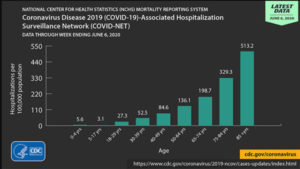
Highlighting the Impact of COVID-19 Infections on Older Adults in the United States
Dr. Lee Meyer
Older adults in the United States are a high-risk group for acquiring the COVID-19 coronavirus and experiencing the greatest impact in morbidity and mortality. For people over sixty-five years of age in the United States, the statistical data are very different than the data familiar to most people and reported in the news each day.
Morbidity and Mortality
At the time of this article, the total known cases around the world are approaching 17 million total cases and over 661,000 deaths. In the United States (2019 population of 328.2 million), the total number of known cases is approaching 4.5 million cases (1.4% of the population) and 150,000 deaths. The ratios of deaths to total cases are 3.8% and 3.3% respectively. How does the numbers for the elderly in the U.S. compare to this view of all ages?


Data from the U.S. Centers for Disease Control’s (CDC’s) National Center for Health Statistics (NCHS) Mortality Reporting System shows a disproportional hospitalization rate for increasing age groups with the rates for adults increasing roughly 150% for each 10-year age group starting at 18 years old. Hospitalizations per 100,000 population (infected or not) among those 65 – 74 years old are nearly 200 (2%), for those 75 – 84 years old are about 330 (3.3%) and 513 (5.1%) for those 85 years and older.
Of the deaths related to COVID-19 alone, 80% of those individuals have been over 65 years of age. The deaths of residents in nursing homes represent over 50% of the total deaths per state in 10 of the 50 states. That population is enumerated by the CDC: in the U.S. in 2016, the CDC recorded 15,600 nursing homes (skilled nursing facilities) with 1.7 million beds (average: ~108 residents per facility).
Social and Lifestyle Impact
The precautions recommended by the CDC include masking and social distancing. For older adults in licensed health facilities and in licensed residential facilities (e.g. assisted living), those common precautions translate to prohibiting in-person visitors, even family.
The treasured moments and experiences of being retired – being a grandparent, starting new ventures, traveling, diving into lifelong hobbies and interests are all on hold for those otherwise healthy seniors. Those older adults in skilled nursing and assisted living facilities (as well as other group-living situations) are unable to experience the simple joys of in-person visits, holding hands, and from family, friends and even spouses. Protecting others is a key concept behind the wearing of masks, social distancing, and hand washing. Older adults may benefit the most from the vigilance and attention paid by all of us to these simple and effective preventative measures.












